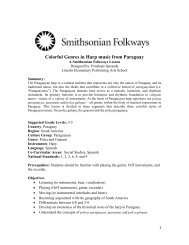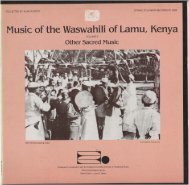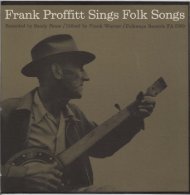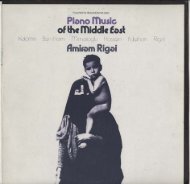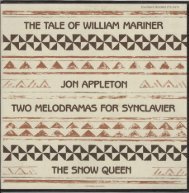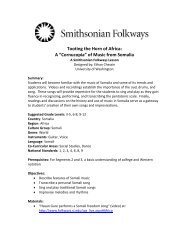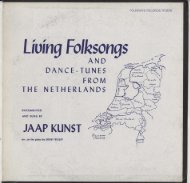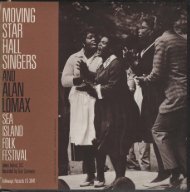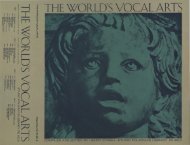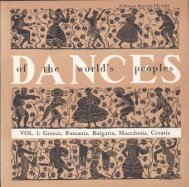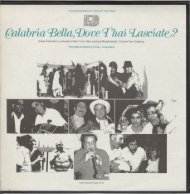Beats, Rhythms, and Drums: Grooves of the World
Beats, Rhythms, and Drums: Grooves of the World
Beats, Rhythms, and Drums: Grooves of the World
You also want an ePaper? Increase the reach of your titles
YUMPU automatically turns print PDFs into web optimized ePapers that Google loves.
d) Introduce <strong>the</strong> natural <strong>and</strong> man-made resources that are readily available to<br />
people <strong>of</strong> a given area. Having looked at <strong>the</strong>se, ask students to think about <strong>the</strong><br />
possible look <strong>of</strong> <strong>the</strong>ir drum again. They should make modifications to <strong>the</strong>ir<br />
vision as needed. As homework, ask students to search <strong>the</strong> environment<br />
(natural <strong>and</strong> manmade environments) for things which could be used to create<br />
drums <strong>and</strong> o<strong>the</strong>r percussion instruments as well.<br />
e) In an about-face, have students st<strong>and</strong> around a large map mural on <strong>the</strong> floor<br />
(preferably one that <strong>the</strong>y created). Review <strong>the</strong> rhythms from yesterday’s<br />
“Jumping Dance <strong>Drums</strong>” musical clip. Although it features three rhythms <strong>and</strong><br />
various instruments in it, focus on <strong>the</strong> drum rhythm. (The rhythm is as<br />
follows, syllabically: don da da don don da don don don. Match it to <strong>the</strong><br />
recording.)<br />
f) Listen carefully to <strong>the</strong> piece again. Ask students to imagine where <strong>the</strong><br />
music might be from. Have <strong>the</strong>m move to that place on a large mural map<br />
which has been stretched across <strong>the</strong> floor. Discuss responses. Then have <strong>the</strong>m<br />
move to <strong>the</strong> place where <strong>the</strong> song is actually from - <strong>the</strong> Bahamas, in <strong>the</strong><br />
Caribbean. (Consider that students may choose <strong>the</strong> African continent as <strong>the</strong><br />
source <strong>of</strong> <strong>the</strong> piece, <strong>and</strong> how it will be necessary to trace <strong>the</strong> journey across<br />
<strong>the</strong> Atlantic Ocean from <strong>the</strong>ir “guess” <strong>and</strong> <strong>the</strong> real course.)<br />
g) Students can take this rhythm, <strong>and</strong> instead <strong>of</strong> using drums, repeat <strong>the</strong> rhythm<br />
using ano<strong>the</strong>r “instrument.” Using typical materials <strong>and</strong> student supplies<br />
found in a classroom (pencils, clips, markers, stones, popsicle sticks, rubber<br />
b<strong>and</strong>s, paper, etc), encourage students to create <strong>the</strong>ir own “musical<br />
instrument” to repeat <strong>the</strong> “Jumping Dance <strong>Drums</strong>” drum rhythm. Students can<br />
work independently, as partners, or in small groups.<br />
Assessment: Students will be able to explain <strong>and</strong> demonstrate <strong>the</strong> sonic effects <strong>of</strong> certain<br />
elements <strong>of</strong> percussion instruments, <strong>and</strong> <strong>the</strong> origins <strong>of</strong> different rhythms <strong>and</strong> percussion<br />
instruments on a global map.<br />
5




